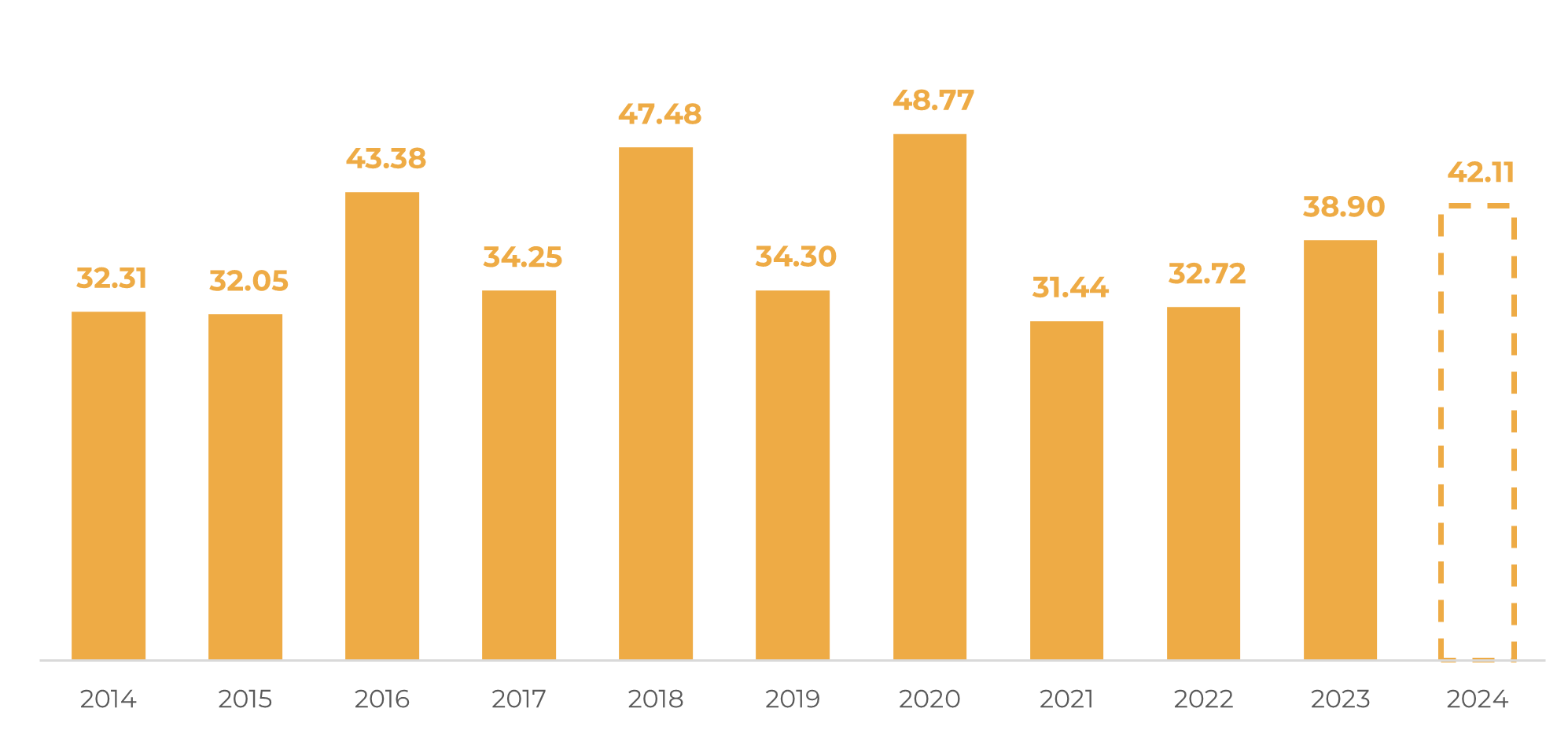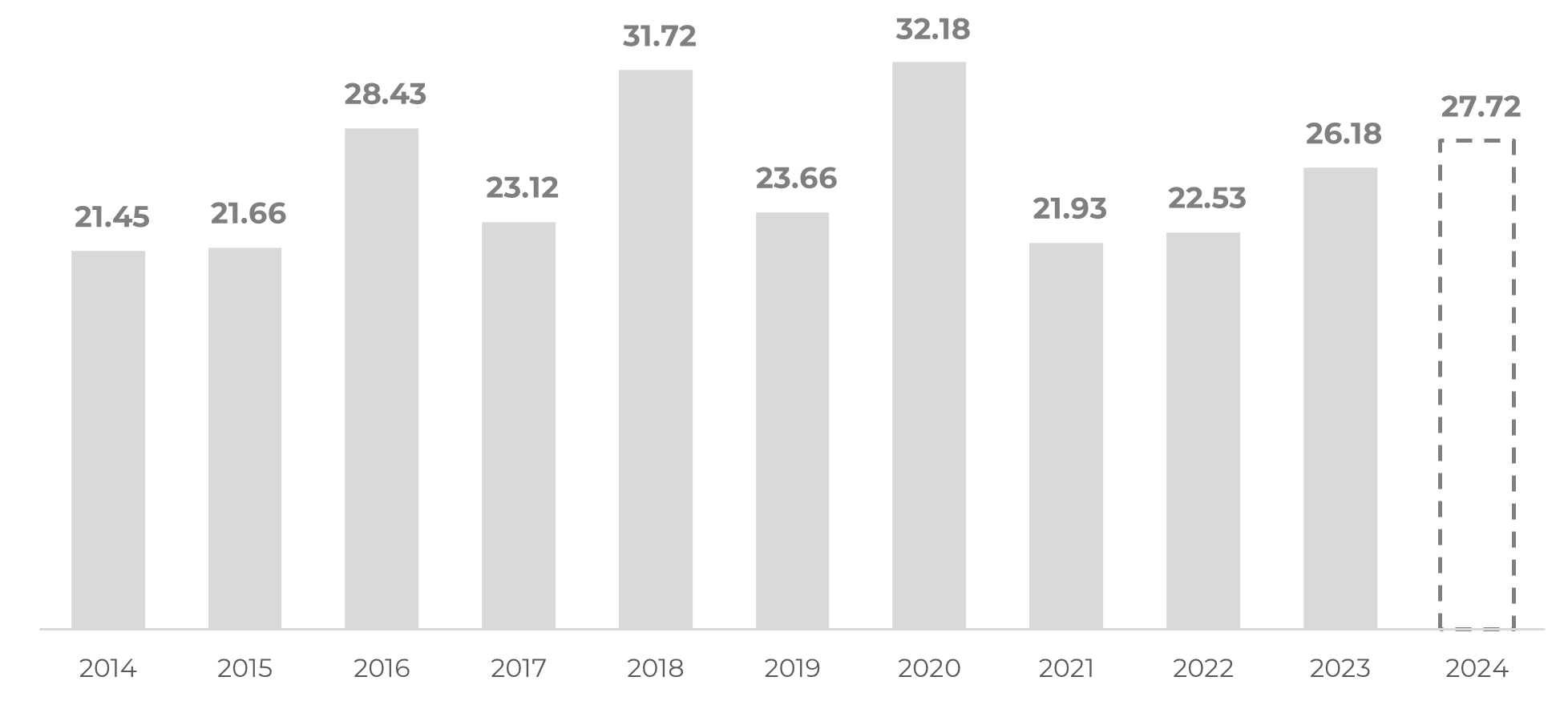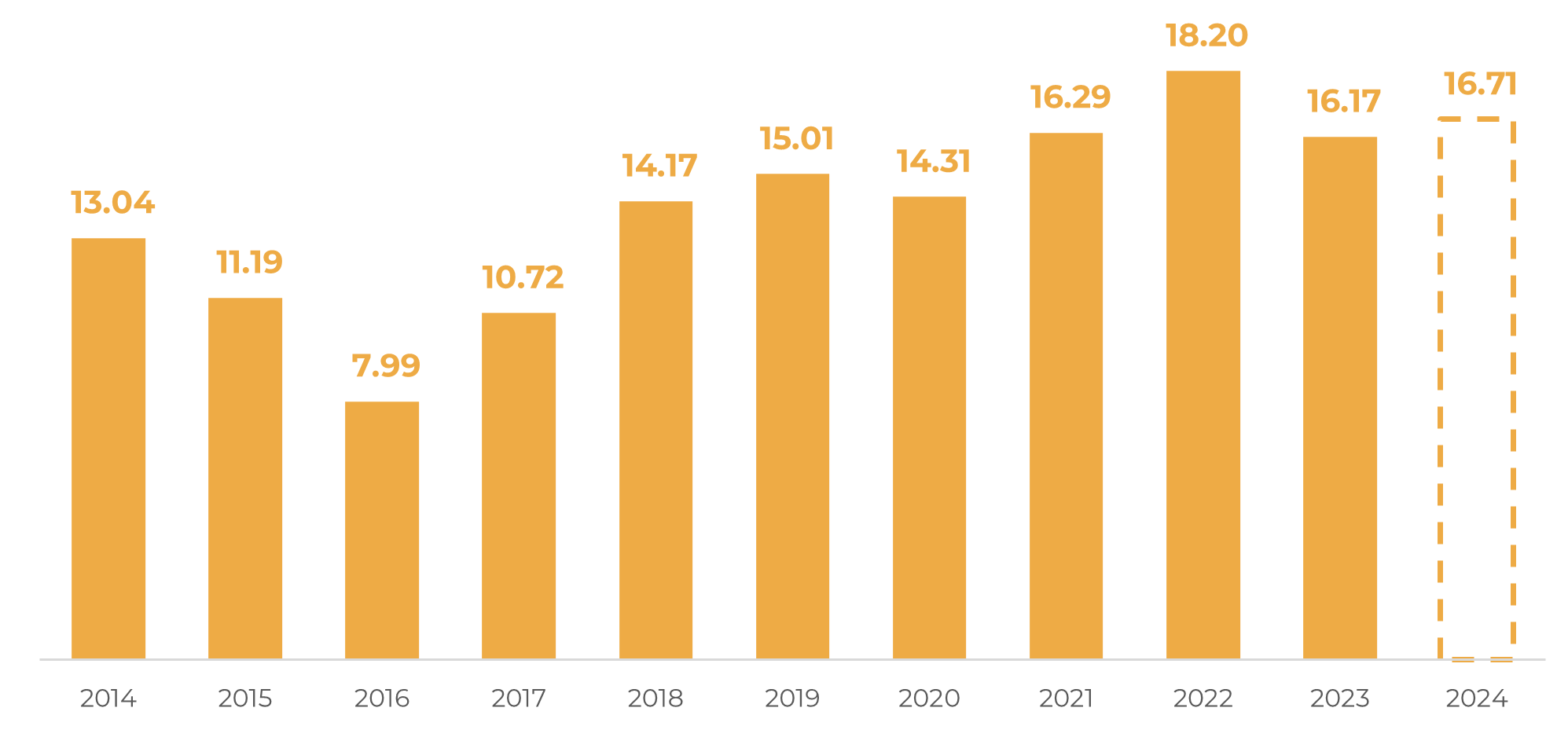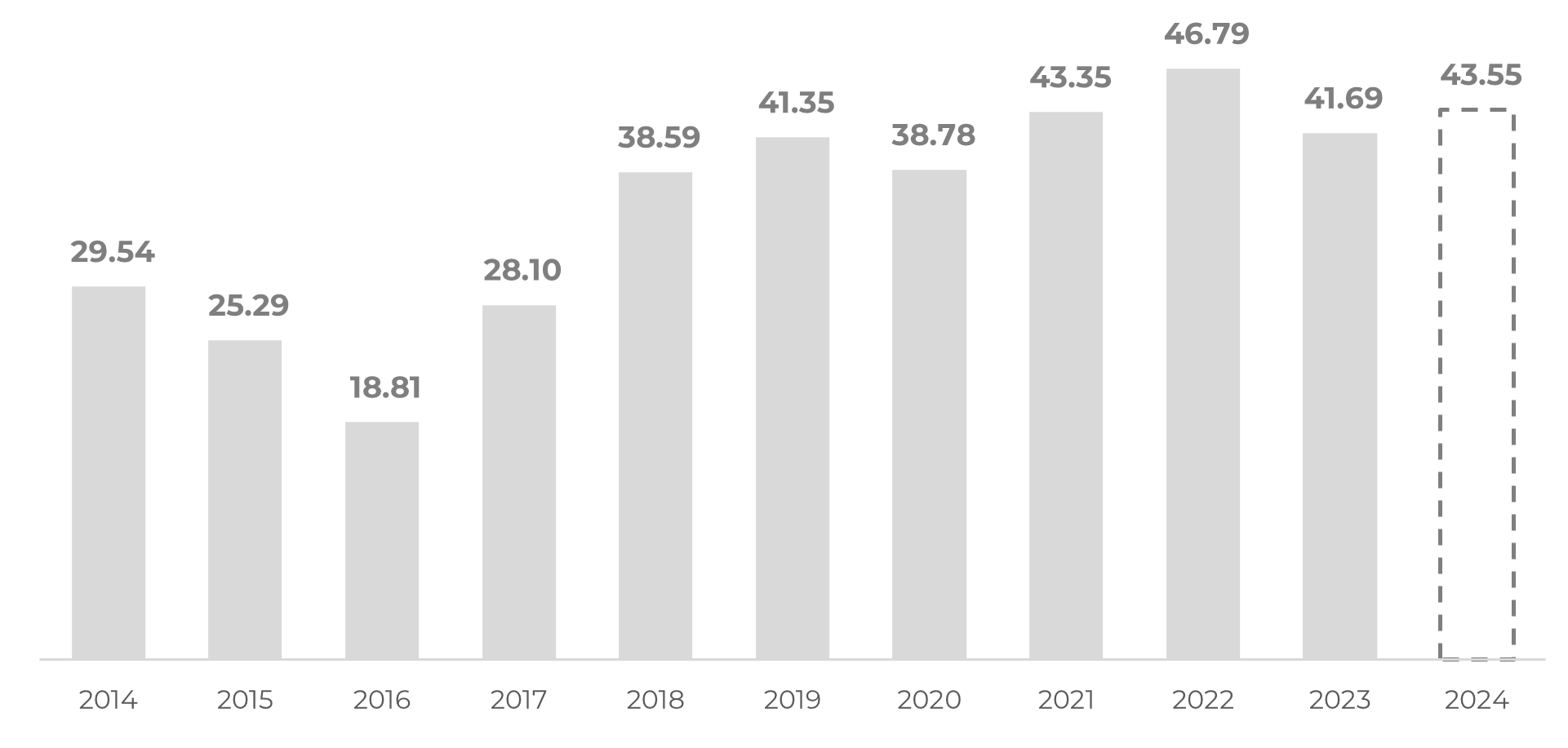
May 24
/
Natália Gandolphi
Coffee Weekly Report - 2024 05 24
Back to main blog page
- Conab's second assessment for the 24/25 Brazilian coffee crop projects 42.11M bags for arabica and 16.71M bags for conilon.
- Arabica production rose by 3% from the previous report and is 8% higher than last year. However, in Minas Gerais, climatic fluctuations resulted in uneven blooming and fruit maturation.
- Conversely, conilon production was revised downward by 626K bags. Despite challenges, such as irregular rainfall and high temperatures in Espírito Santo, advanced practices promise a favorable yield. Bahia and Rondônia also faced irregular weather conditions.
- The report bucks downward reduction expectations prevalent in the market, providing a relatively optimistic outlook when it comes to arabica. However, given the incipient stage of fieldwork, a comprehensive understanding of the crop's potential will only emerge in the following weeks.
Surprise in Conab’s crop update
This week, Conab released its second assessment of the 24/25 crop in Brazil: 42.11M bags for arabica, and 16.71M bags for conilon. The report was a bit surprising when it comes to arabica, given the increase compared to the previous report (+1.4M bags, or +3%). Production is now 3.2M, or 8% above last year’s output.
Conab noted that the coffee crop cycle in Minas Gerais has experienced various climatic fluctuations since September 2023. The first rains, in September, were sparse, followed by a dry period until November. From December 2023 to February 2024, regular rains and mild temperatures favored crop development. However, from February to March, rainfall significantly decreased in some regions.
In South Minas, there was an increase in the production area due to the recovery of crops affected by previous frosts, but the blooming was very irregular, causing uneven fruit maturation. In the Cerrado Mineiro, despite good vegetative conditions, high temperatures and concentrated rains resulted in unevenness and fruit drop. In Zona da Mata, unequal and early blooming due to drought led to a harvest with both green and dry cherries simultaneously, complicating the harvesting process.
Therefore, even pointing out these issues, Conab increased arabica output (resulting exclusively from an improvement in yields).
Figure 1: Brazil – Arabica Production – Conab (M bags)

Source: Conab
Figure 2: Brazil – Arabica Yields – Conab (bags/ha)

Source: Conab
As for conilon, despite the figure itself being lower than the market average, Conab decreased the total volume when compared to the previous assessment (-626K bags).
The agency noted that in Espírito Santo, the coffee crop faced climatic challenges, including irregular and low rainfall combined with high temperatures. Still, the use of advanced agricultural practices and improved clonal varieties has led to a promising yield forecast despite the adverse conditions.
Coffee farms in Bahia, particularly in the Atlantic region, are predominantly family-run, achieving high productivity due to effective ferti-irrigation and semi-mechanized harvesting, although the noted recent climate conditions have caused initial low yields and quality issues.
When it comes to Rondônia, Conab highlighted that the region has benefited from the adoption of high-yielding clonal varieties, resulting in improved uniformity and productivity, though the region has experienced unfavorable climatic conditions, necessitating increased irrigation efforts to support crop development.
Figure 3: Brazil – Conilon Production – Conab (M bags)

Source: Conab
Figure 4: Brazil – Conilon Yields – Conab (bags/ha)

Source: Conab
In Summary
Conab's second assessment for the 24/25 Brazilian coffee crop estimates 42.11M bags for arabica and 16.71M bags for conilon.
Arabica production increased by 3% from the previous report and is 8% higher than last year. In Minas Gerais, climatic fluctuations caused uneven blooming and fruit maturation.
Conilon production was revised down by 626K bags. Espírito Santo faced irregular rainfall and high temperatures but used advanced practices for a promising yield, according to the agency. Irregular weather conditions were also noted in Bahia and Rondônia.
Conab’s report went, in a way, against the current wave of downward reduction expectations – that have reflected a larger share of smaller screens in the early stages of harvest. Still, fieldwork itself is quite incipient, and a clearer view of the full crop potential will only be achieved over the next weeks.
Weekly Report — Coffee
Written by Natália Gandolphi
natalia.gandolphi@hedgepointglobal.com
natalia.gandolphi@hedgepointglobal.com
Reviewed by Lívea Coda
livea.coda@hedgepointglobal.com
www.hedgepointglobal.com
Disclaimer
This document has been prepared by hEDGEpoint Global Markets LLC and its affiliates ("HPGM") exclusively for informational and instructional purposes, without the purpose of creating obligations or commitments with third parties, and is not intended to promote an offer, or solicitation of an offer, to sell or buy any securities or investment products. HPGM and its associates expressly disclaim any use of the information contained herein that may result in direct or indirect damage of any kind. If you have any questions that are not resolved in the first instance of contact with the client (client.services@hedgepointglobal.com), please contact our internal ombudsman channel (ouvidoria@hedgepointglobal.com) or 0800-878-8408 (for clients in Brazil only).
Contact us
hedgepointhub.support@hedgepointglobal.com
ouvidoria@hedgepointglobal.com
Funchal Street, 418, 18º floor - Vila Olímpia São Paulo, SP, Brasil
This page has been prepared by Hedgepoint Schweiz AG and its affiliates (“Hedgepoint”) solely for informational and instructional purposes, without the purpose of instituting obligations or commitments to third parties, nor is it intended to promote an offer, or solicitation of an offer of sale or purchase relating to any securities, commodities interests or investment products. Hedgepoint and its associates expressly disclaim any use of the information contained herein that directly or indirectly result in damages or damages of any kind. Information is obtained from sources which we believe to be reliable, but we do not warrant or guarantee the timeliness or accuracy of this information. The trading of commodities interests such as futures, options, and swaps involves substantial risk of loss and may not be suitable for all investors. You should carefully consider wither such trading is suitable for you in light of your financial condition. Past performance is not necessarily indicative of future results. Customers should rely on their own independent judgement and/or advisors before entering in any transaction.Hedgepoint does not provide legal, tax or accounting advice and you are responsible for seeking any such advice separately.Hedgepoint Schweiz AG is organized, incorporated, and existing under the laws of Switzerland, is filiated to ARIF, the Association Romande des Intermédiaires Financiers, which is a FINMA-authorized Self-Regulatory Organization. Hedgepoint Commodities LLC is organized, incorporated, and existing under the laws of the USA, and is authorized and regulated by the Commodity Futures Trading Commission (CFTC) and a member of the National Futures Association (NFA) to act as an Introducing Broker and Commodity Trading Advisor. HedgePoint Global Markets Limited is Regulated by the Dubai Financial Services Authority. The content is directed at Professional Clients and not Retail Clients. Hedgepoint Global Markets PTE. Ltd is organized, incorporated, and existing under the laws of Singapore, exempted from obtaining a financial services license as per the Second Schedule of the Securities and Futures (Licensing and Conduct of Business) Act, by the Monetary Authority of Singapore (MAS). Hedgepoint Global Markets DTVM Ltda. is authorized and regulated in Brazil by the Central Bank of Brazil (BCB) and the Brazilian Securities Commission (CVM). Hedgepoint Serviços Ltda. is organized, incorporated, and existing under the laws of Brazil. Hedgepoint Global Markets S.A. is organized, incorporated, and existing under the laws of Uruguay. In case of questions not resolved by the first instance of customer contact (client.services@Hedgepointglobal.com), please contact internal ombudsman channel (ombudsman@hedgepointglobal.com – global or ouvidoria@hedgepointglobal.com – Brazil only) or call 0800-8788408 (Brazil only).Integrity, ethics, and transparency are values that guide our culture. To further strengthen our practices, Hedgepoint has a whistleblower channel for employees and third-parties by e-mail ethicline@hedgepointglobal.com or forms Ethic Line – Hedgepoint Global Markets.Security note: All contacts with customers and partners are conducted exclusively through our domain @hedgepointglobal.com. Do not accept any information, bills, statements or requests from different domains and pay special attention to any variations in letters or spelling, as they may indicate a fraudulent situation.“HedgePoint” and the “HedgePoint” logo are marks for the exclusive use of HedgePoint and/or its affiliates. Use or reproduction is prohibited, unless expressly authorized by HedgePoint. Furthermore, the use of any other marks in this document has been authorized for identification purposes only. It does not, therefore, imply any rights of HedgePoint in these marks or imply endorsement, association or seal by the owners of these marks with HedgePoint or its affiliates.

